Adventure Gear Review
Adventure Gear Review
Part of the fun of any motorcycle trip is in the planning. Envisioning the cool assortment of gear you'll need to assemble to make the trip safe, comfortable and possible is right up there with spreading the maps out on the floor when it comes to fun. When it came to deciding which gear to use for my 1 year long trip from Canada to the tip of South America, this involved hours upon hours of research, reading websites, blogs and magazines, as well as trying on riding gear, and talking to fellow riders.
Choosing the correct gear for any adventure is important, however this is even more critical when long distance motorcycle riding is concerned. You need to have protective riding gear, it has to be weather-proof and multi-purpose, and since you can't carry a lot of stuff on a motorbike you've got to make it count.
For my trip which included both the northern and southern hemispheres and had an altitude range from -86 m (-282 ft) in Death Valley to 4980 m (16,338ft) in the Andes of Peru, I needed gear that would perform well in all conditions. I could not afford to wait around for good weather, I had to keep moving regardless of the wind, rain or snow, all of which I encountered in large amounts. I also needed my equipment to provide as much safety as possible, because getting hurt, especially in the middle of nowhere was not part of the plan. Here is an overview of some of the gear I used on my recent, 47,000, 14 month, Canada to Argentina trip.
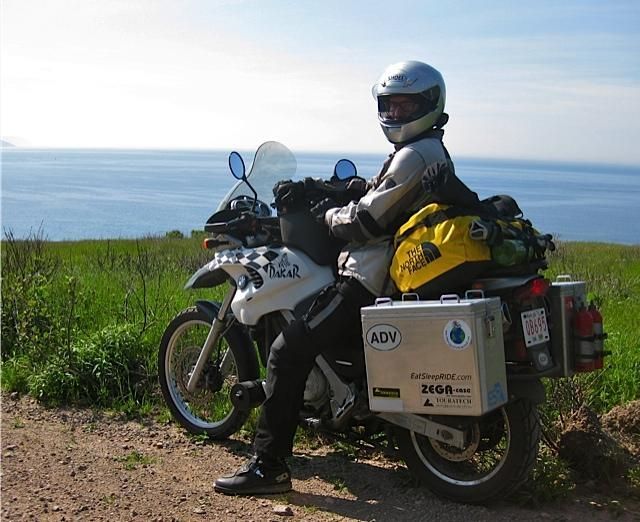
Cayenne Pro Near Meat Cove, NS.jpeg
Rev'it Cayenne Pro Jacket and Pants
The Rev'it Cayenne package certainly is not the cheapest choice of riding gear out there. Listed at $US599.99 for the jacket and $US439.99 for the pants at some online retailers (for some reason the jacket alone is listed at over $700 CAN at my local motorbike shop… ), it represents a pretty significant investment. Personally, when it comes to riding equipment, I think it is a good idea to go with the best possible gear you can afford.
I looked at a number of similarly priced adventure riding options from Alpine Stars, BMW, Olympia and Frank Thomas, to name a few, all of which looked pretty good. I read a couple of on-line reviews and spend quite a bit of time checking out my options. Whatever I choose had to tough wearing, practical and suitable for both warm and cold conditions. Ultimately they also had to provide the maximum level of safety incase of an accident. For me it really came down to the BMW Rally 2 Suit or the Rev'it Cayenne Pro, I thought they looked the best and felt the safest. They also seemed to have a large number of satisfied customers, so I was feeling pretty confident about my options.
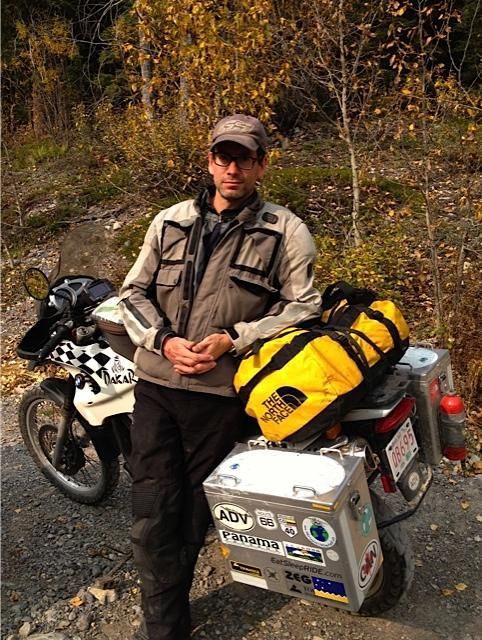
Rev'it Cayenne Pro Jacket and Pants.jpeg
The BMW suit was fantastic, it ticked all the boxes however it was really expensive. I'd be stretching my budget with the Cayenne Pro and the Rally suit was quite a bit more on top of that. Plus I felt the BMW Rally 2 suit was a bit too 'BMW' for me, if you know what I mean. Too many BMW roundels and questionable German fashion aesthetics, but it fit great and felt incredibly solid. If it weren't so expensive I probably would have bought it. Plus, as an added bonus, my wife could have lived out some of her Ewan McGregor, Long Way Round fantasies. Sadly for her, I went with the Cayenne Pro suit in the end.
The Rev'it jacket and pants are made of Cordura 500D and 1000D and use CE approved armour in the knees, elbows, and shoulders. They also have something called 'Super Fabric' on some of the high friction zones like the elbows and knees. Unfortunately the jacket came with a very cheap feeling foam back protector, so it was necessary to upgrade to the SAS-TEK back protector ($US50) which seems like a quality item. The suit feels like a very safe package, it even has 2 options to zip the jacket and pants together. Luckily, I have not had the opportunity to test the suit's safety claims in anything more than slow speed tip overs and the occasional off road spill, which suits me just fine.
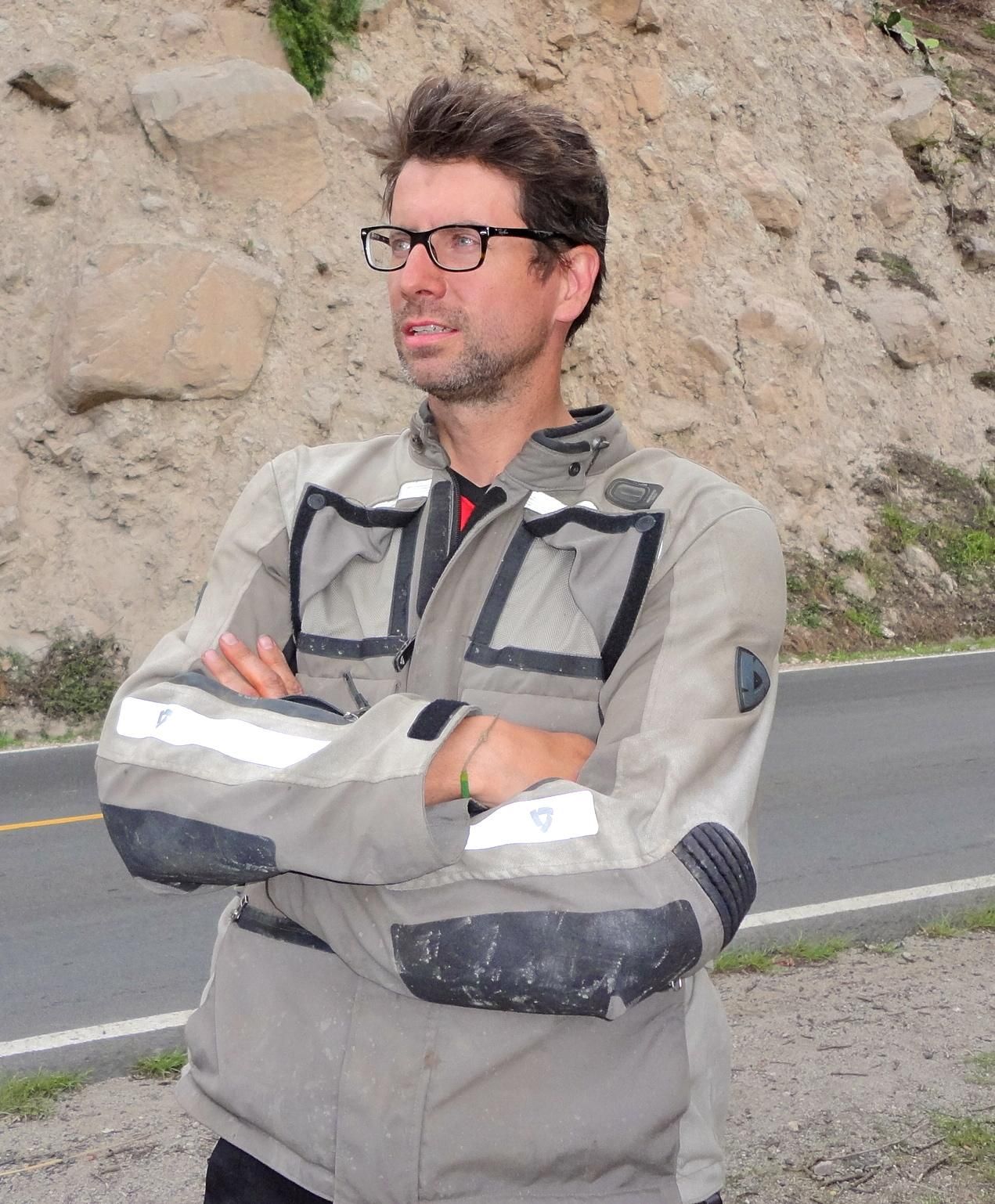
Cayenne Pro Jacket in Peru.JPG
Both the jacket and the pants come with 2 liners, a waterproof, windproof liner and a very cozy thermal liner for when the temperature drops, making this the closest thing I've seen to a true 4 season riding suit. I've ridden with it from -5C to +43C and although it's not perfect at either of theses extremes, it did the job adequately. For really cold weather riding I usually forgo the thermal liner and slip my heated vest under the jacket, and so equipped I feel invincible against the elements.
As the mercury rose the jacket and pants combo struggled to cope. Since I was committed to riding with 'all the gear all the time' on this trip, I had to endure a couple of uncomfortable rides across the desert, most notably in Texas. The jacket has four vents on the front, two on the back and one on each of the sleeves which does help, but the heavy duty Cayenne Pro can't compare to a mesh or light weight jacket when it gets really hot. I've found in extreme heat it is manages to keep you somewhat cool as long as you keep moving, but the moment you stop, you melt.
Coming in at 197cm in height and 83kg in weight I found Rev'it's designed in the Netherlands, European-cut fit me very well. Some more muscled or more portly riders might find the fit a tad constraining, especially those with really broad shoulders, but it fit me to a tee. The beefy CE approved armour did not negatively impact the overall comfort of the suit, in fact I think some of the pads could be a bit larger, especially on the knees and elbows. Seven pockets on the outside of the jacket, plus one on the inside and two more in the pants might be a bit overkill, but it does add to the overall functionality. I seemed to spend a lot of time looking through the pockets trying to find my keys. The two waterproof pockets on the front of the jacket did a great job of keeping my important stuff dry as could be.
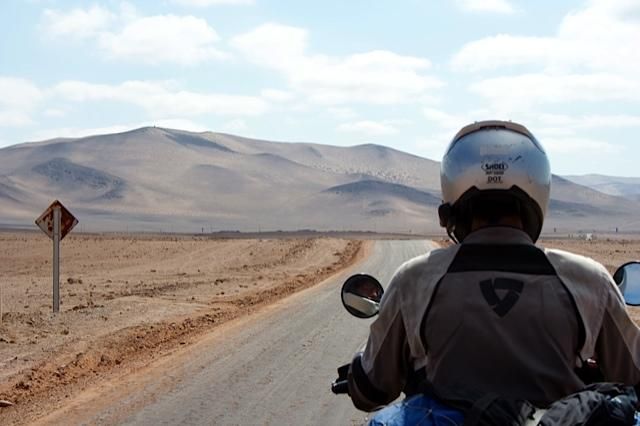
Rev'it Cayenne Pro in the Atacama, Chile.jpeg
Although we rarely rode at night, I felt Rev'it could have done a better job of making the jacket more visible in low light conditions. Sure, I chose the grey and black colour scheme over the bright orange version that was also on offer, however some more reflective material would be appreciated. There are prominent strips on the forearms and on the side of the legs, however the only shiny stuff on the back in is a wide reflective strip across the waist. This may not be a problem riding around town, however on a long overland trip most riders, myself included carry a duffle bag on the rear rack or have a top box on the back, and this completely obscures the reflective material. Relocating the reflective strip across the shoulders would go along way in making the jacket more visible in the dark without having to resort to a hi-viz hue.
I've owned the Cayenne Pro suit for a number of years now and covered well over 50,000km in all types of weather and all kinds of roads and non-roads, in North, Central and South America. I've also used it as a pillow, as a beach blanket and as a work surface and it keeps on going. It has held up surprisingly well. Some of the 'Super Fabric” is peeling away on the pants, the waterproof lining has worn out on one of the pockets (fixed with duct tape), a couple of the zipper pull tabs extensions on the YYK zippers have come off (replaced with zip ties) and there is a slight tear on one of the pockets where I caught it on something. Otherwise the jacket and pants are in great shape and have a few more good years ahead of them. The jacket and pants even clean up well, I've washed them a number of times as the light grey colour does seem to attract a lot of dirt. All in all I'd rate it as the best piece of kit I own, I would not have changed it for anything.
Sidi Discovery Boots
The Sidi Discovery boots are a nice compromise between a touring boot and a motocross boot. They are made of heavy duty leather and have some solid looking armour on the heel, toe and shin, not to mention very sturdy soles which are great for standing on the pegs. Unlike so many motocross boots, the Discovery boots don't squeak when you walk, they are not THAT hot, and once broken in, they are even good for a short hike. After several years and more than 50k km of wear and tear, my Sidi Discovery boots still look great.
The boots have worn very well. Sure, there are a lot of scuffs and scrapes on them, and they desperately need to be resoled (replacement soles are available from Sidi), but they remain fully functional. The unique cam-buckle system works great, and none of the buckles have broken or fallen off. The replaceable metal toe caps are long gone, but they made a bit of a clicking sound on some surfaces when I walked around so I don't really miss them.
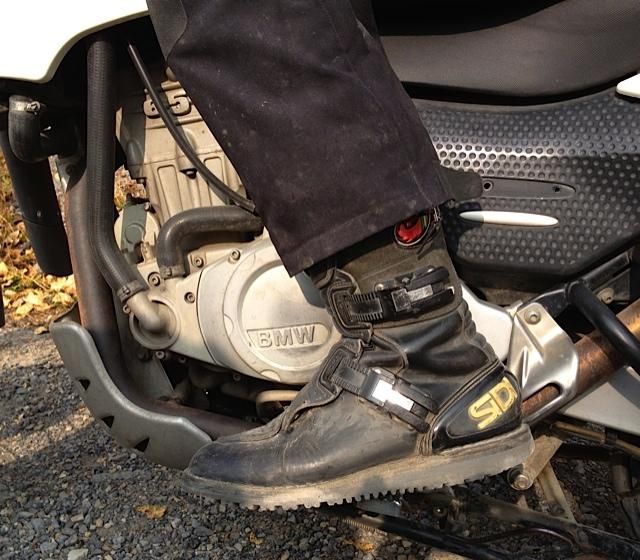
Sidi Discovery on the Bike.jpeg
I had the pleasure of riding through Central America at the height of the rainy season. We encountered dozens of new water crossings and rode around, through and over what seemed like hundreds of landslides, and I felt very secure wearing the Discovery boots. I also felt wet. In fact I felt very wet, as they were not even remotely water proof, which is my only real complaint. When you combine the total lack of water resistance and the tropical heat you get another problem; they were more than a little stinky. Of course, that could have been just be me. Also, after wearing the boots almost everyday for a year they have left a faint line around both of my calves. I consider that to be some kind of badge of honour.
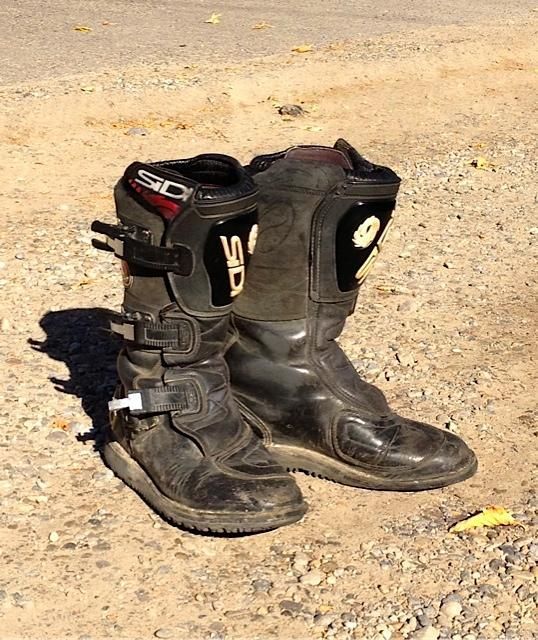
Sidi Discovery Boots Still Going Strong.jpeg
It is my understanding that Sidi has slightly redesigned the boots in recent years, and since they are now called the Discovery Rain I assume that they have addressed my one complaint. Overall, I'd say they are a great boot, they served me well and it's highly likely that my next pair of boots will also come from Sidi. At just over $US300, they are not exactly cheap, but I think they represent good value and are almost ideal for the adventure tourer. They are tough, reliable and comfortable which is why you'll see a lot of other riders on wearing Sidi Discoverys both on and off road.
Shoei RF1000 Helmet
I was really hoping to nail full ‟Adventure Rider” look by adding an Arai XD-3 (Tour-X) or Shoei Hornet to my kit, those high quality, peaked helmets look the business and fit great. Many of the the overland riders we met along the way wore those helmets and loved them. However, there were a couple of issues standing between me and a new XD-3 or Hornet; they are pretty expensive and I had a perfectly good Shoei RF1000 sitting on the shelf. Although it broke my heart, in the end I decided to save a little cash and go with the helmet that I already owned.
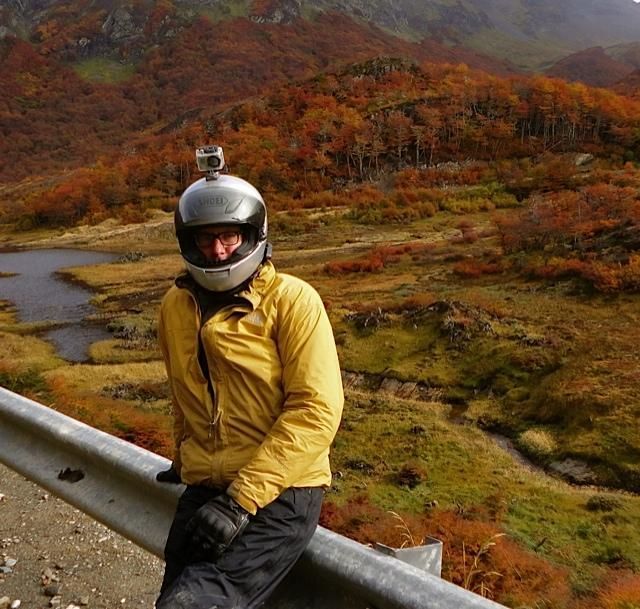
Shoei RF1000 in on Tierra del Fuego.jpeg
The RF1000 is a great helmet, the fit and finish are really top notch. I found it very comfortable, I could wear it all day and it was even fairly quite, which adds to the wearability on a trip like that. It also had deep ear pockets so the Cardo Scala Rider bluetooth communication system was a snap to install. It was fairly light, provided excellent visibility and it was even fairly cool during hot weather riding.
On the down side it does not come with a fully removable liner, which is kind of important if you wear your helmet everyday in the tropics. I'll spare you the details, but suffice it to say it needed to be throughly cleaned on a regular basis. I also found the helmet misted up fairly easily in cool or cold weather. The helmet did not come with a pin lock or similar anti-fog device, so I had to ride with less than ideal visibility is some situations that warranted a better view.
Although the helmet performed as advertised, I soon realized that I was wearing the wrong kind of helmet. And no, I was not regretting my decision to forego the purchase of the XD-3 or Hornet. I learned was that my wife had chosen wisely and had purchased a flip-up modular helmet. After a couple of months on the road I was deeply jealous of her ability to just flip up the front of the helmet to talk to people at gas stations or when asking for directions. Police checks, border crossings, and even photo stops became a bit of a chore, as taking off and putting my helmet back on a dozen times a day became a pain in the neck (and ears!).

RF1000 in a cart, Argentina.JPG
Next time I embark on a trip like this I will definitely do it with flip up helmet on my head, it would have made things so much more convenient. It seems all of the major helmet producers now have flip-up / modular helmets in their line ups, including Shoei, Nolan, Schuberth, HJC and Shark, so there are many choices to be had.
Summary
Clearly, you don't need to have specialized ‟adventure touring” gear to do a big trip, we even met a few people not wearing any motorcycle gear except that which was required by law (i.e. helmets in most countries). I wouldn't recommend riding without the most protective gear you can afford, good gear really can make the journey safer and more pleasant. The adventure-specific gear takes that one step further, it is designed with isolated, rough, long distance riding in mind and I think it is worth it.
Looking back at my gear, I wouldn't change much. My jacket and pants were a near perfect four season compromise. I would have preferred if my boots were waterproof but I was very happy with them. As for the helmet, I'd definitely change it, but not because it was a bad helmet, on the contrary, it was very good, it was just the wrong type of helmet. A flip-up is definitely the way to go.
You must be logged in to comment
Login now
Sandra's Daytona boots are still 100% waterproof after well over 50,000km, and for what she paid for them they should be. Her review of them can be found here: http://eatsleepride.com/c/5258
I really think flip-up is the way to go for long distance travel and touring. I've spoken to many overland riders who wear flip ups and most swear by them. It just makes everything easier when you spend everyday on the road. Sandra's Nolan has developed a few issues with the internal sun visor, but otherwise works well. I've heard the Schuberth C3 or the BMW System 6 (made by Schuberth, I think) are both fantastic, if extremely expensive. The Shoei Neotec looks pretty good and may be my next helmet, regardless of what type of riding I'm doing (unless I find myself on the track).
Interesting about you would wear a flip front helmet next time. Most people I've canvassed say stay away - they often develop mechanism problems and it's the one thing that's stopped me from getting one
I've ridden in quite a few boots and am not surprised you say the Sidi's are not waterproof. My Gaerne SG10's are mostly waterproof. but the ones I ride in now (Sidi Goretex) are the completely so. I've stood in water way past the ankle and never felt damp. Sweaty is a different matter. Two years and at least 25,000km in them, they still feel great